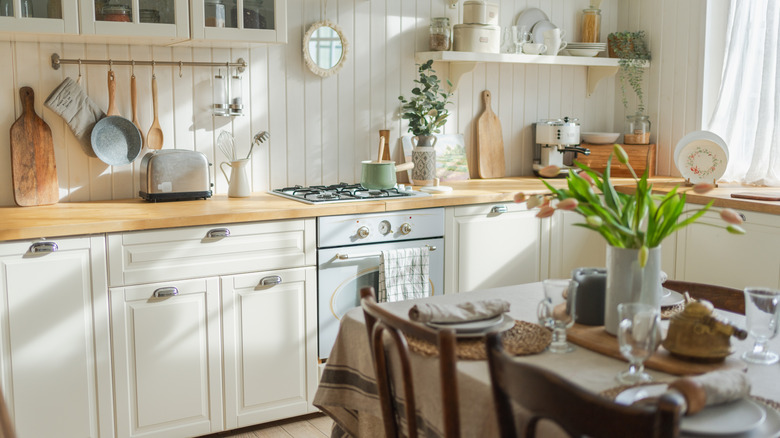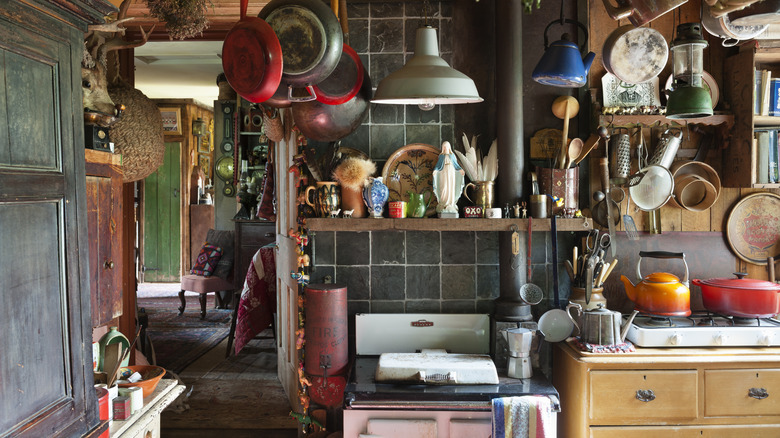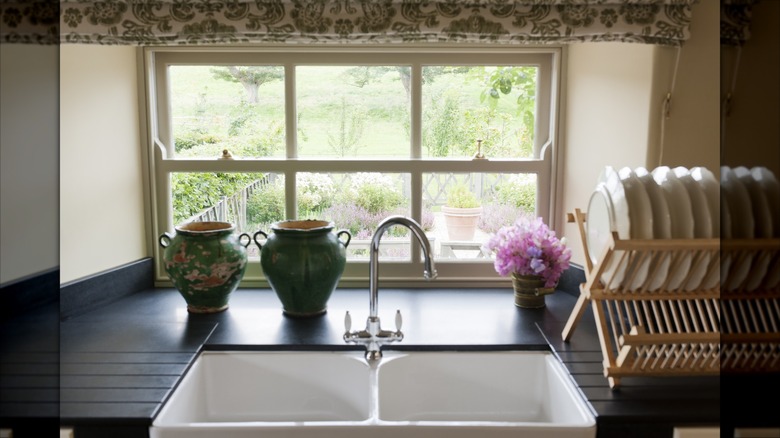The Short-Lived Kitchen Trend That Won't Be Booming In 2025
Kitchens are for gathering and making connections with loved ones, so it's no surprise that so many people have embraced the cottagecore aesthetic inspired by rustic lifestyles of old. Incorporating exposed wood beams and vintage butcher block islands, open shelves that decoratively display vintage china, and floral patterns that show up everywhere from dish towels to cabinet skirts, the trend has taken the world by storm. The earthy materials and slightly distressed quality of the style are a nod to the slower pace of country life. Growing vegetables. Raising chickens. Baking bread. But will this kitchen trend keep booming in 2025? Design historian Sarah Bilotta doesn't think so.
"I can understand why some experts may believe the cottagecore kitchen trend won't be as popular in 2025," she said in her exclusive interview with House Digest. "It has been around for a while, and the influencers responsible for coining the term and developing the design genre are developing new tastes and interests." In fact, barn doors, natural wood shaker cabinets, and hanging pot racks are among the once-popular kitchen trends that won't be regaining their popularity anytime soon.
In the future, Bilotta anticipates seeing more simple and practical kitchen designs in the future. "I definitely don't think that the cottagecore kitchen is going to disappear altogether," she said. "The idea of a rural cottage kitchen has survived in many iterations for centuries, and I believe that some aspects of this style will continue, while others will fade from popularity."
Cottagecore kitchens can end up feeling claustrophobic
Unlike the cottage kitchen fantasy of today, old European kitchens and sculleries were not historically used as gathering spaces. Instead, they were designed to be functional rooms that would contain the mess, heat, and noise involved in preparing food, washing dishes, and storing kitchenware. They weren't highly decorated or luxurious by any means, typically occupying a small area toward the back of a home rather than the central location found in today's modern floor plans.
Nowadays, the stone fireplaces, open fires, and iron cookware commonly used in historic kitchens aren't generally relevant or affordable. Those who love the cottagecore look need to embrace accessories and finishes that are evocative of period styles, apothecaries, and farmhouses. This frequently creates a cluttered and claustrophobic feeling instead of a calm and curated one. "Today's cottagecore kitchens are largely inspired by some faint idea of an idyllic yet humble European rural lifestyle formed in our collective cultural memory," Sarah Bilotta told House Digest in our exclusive interview. "It's definitely not straight-from-a-sourcebook design, but rather an amalgamation of a lot of different (and quite traditional) European and American design elements." Needless to say, it's not for everyone.
What to do if you still love the look
Like approaching maximalism successfully, getting your cottagecore kitchen to look "just right" can be a challenging proposition, especially as design trends shift. In her exclusive talk with House Digest, Sarah Bilotta mentioned Shaker-style cabinets, abundant open shelving, and Windsor-style chairs as simple ways to bring the cottagecore aesthetic into your home. "The 'cottage' part of cottagecore is especially evident in kitchens in this style, which are typically packed to the brim with knickknacks, emphasizing the compressed footprint of a rural scullery," she explained.
To make sure your kitchen doesn't look outdated, be more intentional by using one or two coordinating patterns instead of a cacophonic mix of ditzy florals, gingham, and lace that typifies the cottagecore style. Bilotta went on to say that while the practicality of deep farmhouse sinks will continue to make them a popular choice, wide open shelving requires too much work to keep tidy. She also expects to see fewer kitschy knickknacks displayed in the future, and pattern is another area where you can expect to see a departure from the "more is more" mindset.
In 2025, you can expect to see changes in the realm of color too. "The neutral tones of cottagecore kitchens, typically earthy terracottas, dusty blues, and sage greens, are going to be slowly replaced by bolder colors," Bilotta predicted. "I have already come across some new, really gorgeous farmhouse-inspired kitchens that lean heavily into deep emerald greens and rich royal blues." The design historian assures anyone who loves cottagecore style that wood paneling, beams, and unique weathered light fixtures aren't going anywhere.


